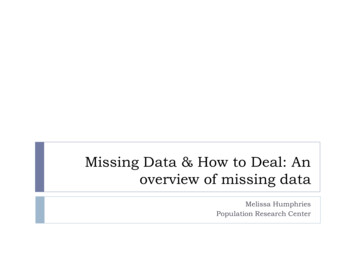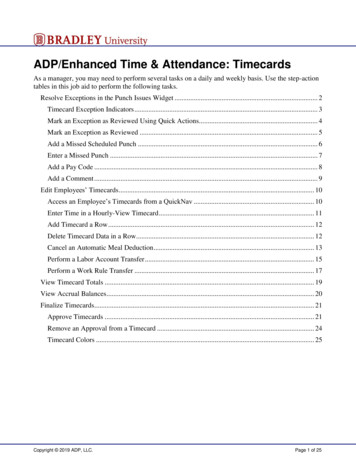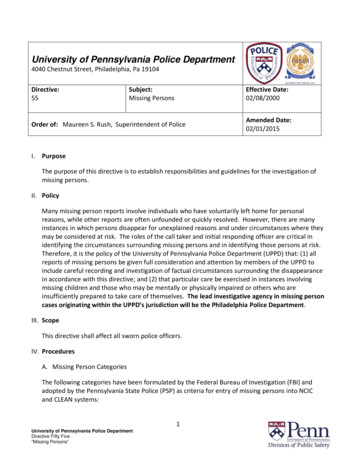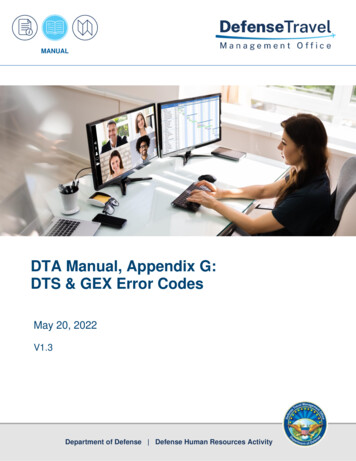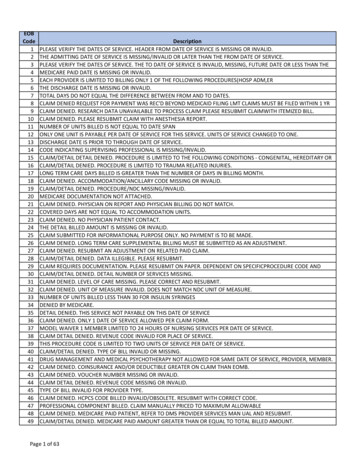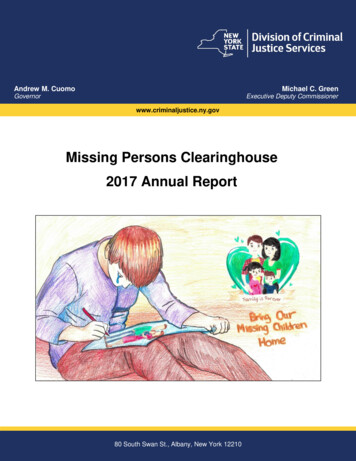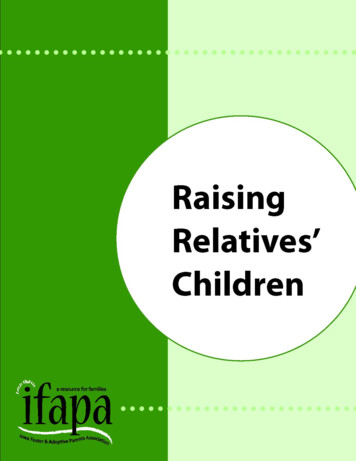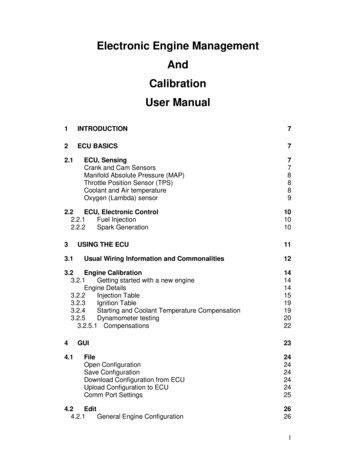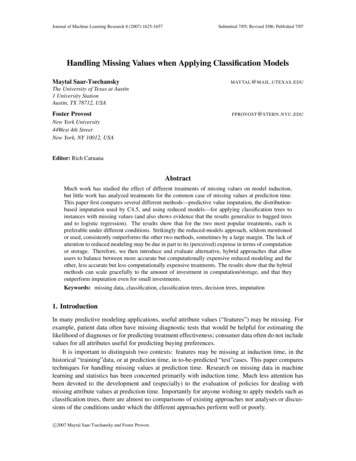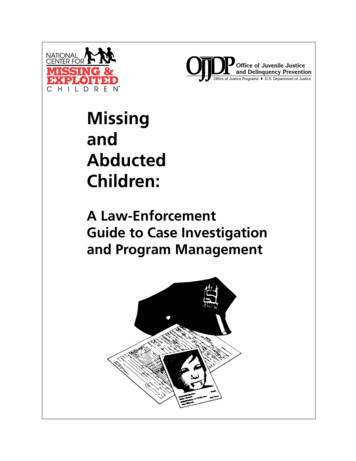
Transcription
MissingandAbductedChildren:A Law-EnforcementGuide to Case Investigationand Program Management
Missing and Abducted Children:A Law-Enforcement Guide toCase Investigation and Program ManagementFourth Edition2011Edited byPreston Findlay and Robert G. Lowery, Jr.National Center for Missing & Exploited Children Charles B. Wang International Children’s Building699 Prince StreetAlexandria, Virginia 22314-31751-800-THE-LOST (1-800-843-5678)ORI VA007019WCopyright 1994, 1997, 2000, 2006, and 2011National Center for Missing & Exploited Children. All rights reserved.This project was supported by Grant No. 2011-MC-CX-K001 awarded by the Office ofJuvenile Justice and Delinquency Prevention, Office of Justice Programs, U.S. Department ofJustice. This document is provided for informational purposes only and does not constitutelegal advice or professional opinion on specific facts. Information provided in this documentmay not remain current or accurate, so recipients should use this document only as a startingpoint for their own independent research and analysis. If legal advice or other expert assistance isrequired, the services of a competent professional should be sought. Points of view or opinionsin this document are those of the author and do not necessarily represent the official positionor policies of the U.S. Department of Justice. Child Victim Identification Program , CyberTipline ,Deliver Me Home , National Center for Missing & Exploited Children , NetSmartz411 ,1-800-THE-LOST , Project ALERT , Sex Offender Tracking Team , and SOTT are registeredtrademarks of the National Center for Missing & Exploited Children.
ContentsAcknowledgments.ixLetter From Ernie Allen.xiiiForeword by John Walsh.xvAn Issue Perspective by Stephen E. Steidel and Preston Findlay.1Quick Reference.1Historical Overview.3The Numbers.11Law Enforcement’s Response to Reports of Missing Children.13Model Policies.14Agency Accreditation.14Significant Trends, Projects, and Programs.14Law-Enforcement Training.15The AMBER AlertTM and Other Missing-Children Notification Programs.15Secondary Distribution of AMBER Alerts.15Alternate Notification Systems.16Child Abduction Response Team.16Protecting Children From Online Victimization.16Developing and Delivering Child-Safety Programs.17Investigation of Family-Abduction Cases by the Prosecutor’s Office.17Missing-Children Clearinghouses.18Newborn/Infant-Abduction Program.18Identifying and Tracking the Sex Offender.19Extending Resources to Missing Young Adults.19Children Missing From Care Project.20Recovery of Long-Term Missing Children.20Reunification of Missing Children.20National Emergency Child Locator Center.21Obtaining Resource Material.21Conclusion.21References: Citations and Related Resources.22The Initial Response by Stephen E. Steidel, Robert Hoever, and H. Wayne Sheppard.25Quick Reference.25Initial-Response Investigative Checklist.27Administrative.27First Responder.28Supervisory Officer.30Investigative Officer.31Initial-Response Components.34Administrative Component.34Call Intake.34Radio Broadcasts.35Nlets.36Fugitive Search Plans.36Special Tipline or Hotline.36Media Relations.36Missing and Abducted Children - iii
First-Responder Component.36Responding to the Scene.36On-Scene Activities.37Supervisory Component.41Debriefing the First Responder.41Establishing a Command Post.42Mobilizing Investigative Resources.42Implementing Perimeter Patrol.42Maintaining Media Relations.43Supervising the Situation.43Investigative Component.44Debriefing the First Responder(s).44Interviewing Witnesses.44Developing Assessment Criteria.45Neighborhood Canvassing.45Roadblock Canvassing.45Activating Response Protocols.46Search Component.46Conclusion.46References: Citations and Related Resources.47Nonfamily Abduction by Charles Masino; Robert G. Lowery, Jr.; and H. Wayne Sheppard.49Quick Reference.49Nonfamily-Abduction Investigative Checklist.51Initial Investigation.51Prolonged Investigation.51Recovery/Case Closure.52Definition of Nonfamily Abduction.53The Initial Response.53Planning.54Tactical Considerations.56Neighborhood Canvass.56Information-Management System.57Use of Polygraph.57Multiple-Suspect Issues: Short- and Long-Term Cases.58Establishing a Command Post.59Hotline.59Family Liaison.60Liaison With Community Groups and Nonprofit Organizations.61Consultation With NCMEC’s Team Adam.62Investigative Considerations.63General.63Regarding Newborn/Infant Abductions.63Statistics.63The Offender.64Use of Violence.66The Response.66Crime-Scene Analysis and Offender Profiles.68The Prolonged Investigation.70Recovery/Case Closure.72Reunification Issues of Nonfamily Abduction.72Guidelines for Handling the Reunification of a Nonfamily-Abducted Child.73iv - Missing and Abducted Children
Conclusion.74References: Citations and Related Resources.74Family Abduction by Preston Findlay, Eliza Harrell, and Maureen Heads.77Quick Reference.77Family-Abduction Investigative Checklist.79Initial Response.79Ongoing Investigation.79Prolonged Investigation.80Recovery/Case Closure.80Definition of Family Abduction.81Initial Response.81Risk Assessment.81NCIC Entry.83Use of Media and Clearinghouses.84Violations of Law.84Determining Legal Guardianship or Custody.85Criminal Law Violations.86Family Abduction: Crimes Under State Law.87Family Abduction: Crimes Under Federal Law.88Using Civil-Court Orders.89Ongoing Investigation.89Prolonged Investigation.92International Cases.93Abductions-In-Progress.93Civil Remedies.95Criminal Remedies.95Other Remedies.97Extradition.97Immigration and Nationality Act.98Deportation.98Passport Revocation.98Passport Fraud.98Diplomatic, Mediated, or Voluntary Returns.99Liability, Immunity, and Other Protections.99Liability for Taking Action.99Liability When No Action Is Taken.100Immunity.100Other Protections From Liability.101Prevention.102Recovery and Reunification.103Conclusion.104References: Citations and Related Resources.105The Runaway Child by Lee Reed.107Quick Reference.107Runaway Investigative Checklist.109The Initial Investigation.109The Prolonged Investigation.109Recovery/Case Closure.110Definition of Runaway Children.111Investigating Cases of Runaway Children.111Missing and Abducted Children - v
Role of the First Responder.111Role of the Assigned Investigator.112Family Residence.112Friends.113School/Teachers/School Resource Officers.113Community Agencies/Organizations.114Assessing Cases of Runaway Children.114Risk Factors.114Runaways and the Internet.115Runaways and the Commercial Sexual Exploitation of Children.116Prolonged Investigation.116Recovery and Case Closure.118Procedural Steps.118Disclosure of Exploitation or Abuse.118Returning Runaways From Distant Locations.119Reunification Issues of Runaway Children.119Guidelines for Handling the Reunification of aRunaway Child.120Evaluation of Agency Policies Regarding Runaway Children.121Proactive Programs.121Conclusion.122References: Citations and Related Resources.122Agency Self-Assessment: Cases of Runaway Children.124Searches for Critically Missing Children by Robert G. Lowery, Jr.; HenrySchmidt; Lee Manning; and Ron Olive.125Quick Reference.125Planning Prior to An Incident.127Initial Response.129Planning the Search.131Lost-Person Behavior.131Probable Distances of Travel.132Typical Behavior of Children Aged 1 to 6.132Typical Behavior of Children Aged 7 to 12.132Health Challenges.133Preparing for the Search: Additional Considerations.133Searches.134Search Tactics: The Basics.134Type I: Hasty Search.134Type II: Systematic Search.135Type III: Thorough Search.136Other Search Considerations.137When a Landfill Search Is Considered.138Documentation.139References: Citations and Related Resources.139Investigative Resources by Stephen E. Steidel and Thomas G. Sirkel Jr.141Quick Reference.141Resource Agencies and Organizations.143National Center for Missing & Exploited Children .143Missing Children Division.144Case Analysis Division.146vi - Missing and Abducted Children
Family Advocacy Division.146Exploited Children Division.147NCMEC Investigative Publications.148NCMEC’s Commitment to Law Enforcement.148National Crime Information Center.148Missing Person File.148Unidentified Person File.149Offline Search.150Federal Agency Task Force for Missing and Exploited Children.151Additional Federal Resources.151Missing-Children Clearinghouses.154Nonprofit, Missing-Children Organizations.154National Association for Search & Rescue.155Local, State, and Regional Resources.155Preincident Planning.156References: Citations and Related Resources.157Crisis Media Relations by Hugh Munn.159Quick Reference.159The Law Enforcement-Media Relationship.161Legal Review.162At the Scene.162Access to Records.163Perceptions.164Crisis Forecasting.164Emergence of the “New” News Reporter.165Managing High-Profile Cases.165Recommendations and Suggestions.167References: Citations and Related Resources.167Management Issues by Thomas B. Smith and H. Wayne Sheppard.169Quick Reference.169Define and Evaluate Current Operational Procedures.171Develop New Operational Policies and Procedures.173Identify New Objectives and Goals.174Consider Establishing a Dedicated Missing-Child Unit.176Evaluate Implementation Issues.176Program Implementation.177Children Missing From Care: Special Management Considerations.179Conclusion.181References: Citations and Related Resources.181Agency Self-Assessment: Missing-Children Preparedness.183Agency Self-Assessment: Children Missing From Care.186Use of Volunteers in Missing-Child Units.187Volunteer Assigned to Missing-Child Unit: Sample Job-Description Statement.188Appendices.191Quick Reference.191Appendix A: NCIC Missing-Person-File Categories.193Appendix B: NCIC Child-Abduction Flag.194Appendix C: Victim/Family Data-Collection Questionnaire.195Index.205Missing and Abducted Children - vii
Table of FiguresFigure 1:Figure 2:Figure 3:Figure 4:Figure 5:Figure 6:Figure 7:Figure 8:Figure 9:Figure 10:Figure 11:Figure 12:Figure 13:Figure 14:Figure 15:Figure 16:Figure 17:Figure 18:Figure 19:Figure 20:Figure 21:Figure 22:Figure 23:Figure 24:Figure 25:Significant Measures Enacted to Assist Children At-Risk.4Key Findings From the Second National Incidence Studies of Missing,Abducted, Runaway, and Thrownaway Children.12Sources of Statistical Information About Missing and At-RiskChildren.13Risk Factors.39Post-Offense Behavior of Killers.40Risk Factors.56The “Typical” Newborn/Infant Offender.65Key Initiatives.82NCIC Tips for Entering Information About Family-Abduction Cases.83Key Questions Regarding Initial Response.85Key Questions Regarding Potential Law Violations.87NCIC Offline Searches.90Records.91Additional Resources.92Key Questions Regarding International Abductions.97Contact Information for Key Resources at the U.S. Department ofState.102Key Question Regarding Return.103Guidelines for Handling the Reunification of a Family-AbductedChild.104Risk Factors.115NCMEC Case Types.144NCMEC Case-Intake Criteria.144Military-Worldwide Locator Services.153Steps to Follow When Evaluating an Agency’s Missing-ChildResponse.171Sample Goals and Objectives.175Potential Division of Responsibilities in a Dedicated MissingChild Unit.177viii - Missing and Abducted Children
AcknowledgmentsThe National Center for Missing & Exploited Children (NCMEC) acknowledges the contributions of the individuals noted below in the design, development, and presentation of theformer Basic Investigative Techniques - Missing and Abducted Children training program and itssubsequent adaptation into this guide. The combined experience, skill, and expertise of thesespecialists along with the suggestions, modifications, and additions provided by our expertreviewers has led to the creation of a comprehensive resource document for all professionalswho are involved in the search for missing children.Principal Authors of This EditionPreston FindlayCounselMissing Children DivisionNCMECAlexandria, VirginiaDetective Charles MasinoMissing Persons Unit (Retired)Phoenix (Arizona) Police DepartmentNCMEC Team Adam ConsultantNewport Center, VermontEliza HarrellFormer Case ManagerMissing Children DivisionNCMECAlexandria, VirginiaHugh MunnFormer Public Information DirectorSouth Carolina Law Enforcement DivisionPublic Relations FacultyUniversity of South Carolina School ofJournalism and Mass CommunicationsColumbia, South CarolinaMaureen HeadsSupervisory Case ManagerNCMECAlexandria, VirginiaRobert HoeverAssistant Bureau Chief, ChildProtection Bureau (Retired)New Jersey State PoliceAssociate Director, Special ProjectsMissing Children DivisionNCMECAlexandria, VirginiaRobert G. Lowery, Jr.Executive DirectorMissing Children DivisionNCMECAlexandria, VirginiaLee ManningLieutenant (Retired)Massachusetts State PoliceNCMEC Team Adam ConsultantAlexandria, VirginiaRon OliveNaval Criminal Investigative Service (Retired)NCMEC Team Adam ConsultantSurprise, ArizonaDetective Lee ReedYouth DivisionAbilene Police DepartmentNCMEC Team Adam ConsultantAbilene, TexasHenry SchmidtUndersheriff (Retired)Sublette County (Wyoming) Sheriff’s OfficeNCMEC Team Adam ConsultantAlexandria, VirginiaH. Wayne SheppardPennsylvania State Police (Retired)Team Adam SupervisorNCMECAlexandria, VirginiaMissing and Abducted Children - ix
Thomas G. Sirkel Jr.Lieutenant (Retired)Los Angeles County (California) Sheriff’s OfficeAssociate Director of Training and OutreachNCMECAlexandria, VirginiaThomas B. SmithLieutenant (Retired)Special Victims BureauCollier County (Florida)Sheriff’s DepartmentNaples, FloridaStephen E. SteidelSuffolk County (New York) Police Department (Retired)Associate Director of Training and Outreach (Retired)NCMECAlexandria, VirginiaContributors and Reviewers of This EditionKristen AndersonDirector of TrainingNCMECAlexandria, VirginiaTerri DelaneyDirector of PublicationsNCMECAlexandria, VirginiaAngela AufmuthSupervisorSex Offender Tracking Team Case Analysis UnitNCMECAlexandria, VirginiaBen ErminiYonkers (New York) PoliceDepartment (Retired)Executive Director of CaseOperations (Retired)NCMECAlexandria, VirginiaPeter D. BanksMetropolitan (DC) PoliceDepartment (Retired)Director of Training (Retired)NCMECAlexandria, VirginiaFrank ConnerSenior InspectorSex Offender Investigation BranchU.S. Marshals ServiceAlexandria, VirginiaDavid CudmoreSpecial AgentWeapons of Mass Destruction CoordinatorKansas City Joint Terrorism Task ForceFederal Bureau of InvestigationKansas City, MissouriPatti DavisSenior WriterNCMECAlexandria, VirginiaErin FitzgeraldPublications SpecialistNCMECAlexandria, VirginiaBud GaylordExecutive DirectorCase Analysis DivisionNCMECAlexandria, VirginiaMarsha Gilmer-TullisDirectorFamily Advocacy DivisionNCMECAlexandria, VirginiaCraig E. HillDeputy Chief of Police (Retired)Leawood (Kansas) Police DepartmentAssociate Director of Training and OutreachNCMECAlexandria, Virginiax - Missing and Abducted Children
Linda KriegFormer Section Chief, InternalInvestigations SectionFederal Bureau of InvestigationAssistant Executive Vice PresidentNCMECAlexandria, VirginiaNancy McBrideNational Safety DirectorNCMECLake Park, FloridaMolly McMinnInspectorU.S. Postal Inspection ServiceAlexandria, VirginiaJanice MertzSupervisory Special AgentFederal Bureau of InvestigationAlexandria, VirginiaChristina MilesPublications SpecialistNCMECAlexandria, VirginiaCathy NahirnySenior Analyst, InfantAbduction CasesNCMECAlexandria, VirginiaJohn B. Rabun, Jr., ACSWFormer ManagerLouisville/Jefferson County (Kentucky)Exploited and Missing Child UnitExecutive Vice President and ChiefOperating OfficerNCMECAlexandria, VirginiaRobin SanfordNCIC AnalystCase Analysis DivisionNCMECAlexandria, VirginiaMelinda StevensDirectorMissing Children DivisionNCMECAlexandria, VirginiaEric TrestSpecial AgentNaval Criminal Investigative ServiceMilitary Criminal Investigative OrganizationRepresentative to NCMECAlexandria, VirginiaThanks also to the many individuals, both from within NCMEC and associated agencies andorganizations, who assisted with prior editions of this guide and those who are always willingto share their experience, knowledge, and ideas to help ensure this guide contains the mostmeaningful and accurate information possible.Missing and Abducted Children - xi
LetterDear Friends In Law Enforcement:Congratulations on receiving this fourth edition of Missing and Abducted Children: A LawEnforcement Guide to Case Investigation and Program Management. We are proud the U.S. Departmentof Justice was part of the development of this important guide to assist law enforcement ininvestigating missing- and abducted-children cases. The partnership between the Office of JuvenileJustice and Delinquency Prevention within the U.S. Department of Justice and National Centerfor Missing & Exploited Children (NCMEC) allows us to provide key resources in your searchfor missing and abducted children. We commend the work you do to serve and protect familiesin your jurisdiction and hope you will call on us to help in these cases.In the words of Attorney General Eric H. Holder, Jr., as stated to those assembled at theU.S. Department of Justice’s National Missing Children’s Day Ceremony on May 25, 2010, inWashington, DCSo many of you help to lead this work — both the award recipients we honor today,as well as the unsung heroes who work, day in and day out, to recover missing childrenand bring families back together. Many of the advocates here in this Great Hall haveturned tragedy in their own homes into a commitment, and opportunity, to help others.Many of the officers have found ways to fuse cutting-edge technologies with traditionalmethods of law enforcement and recovery — harnessing the Internet in new wayswhile never losing sight of the value of knocking on doors and tacking up postersacross town. And all of you have been strong, empathetic, and utterly determined inthe face of devastating circumstances and difficult odds . [S]upporting and advancing this work is, and will continue to be, a top priorityfor the Department of Justice. Before the media, before the experts, before anyoneelse, families in crisis turn — first — to law enforcement. In these officers, desperateparents, grandparents, and guardians place their trust, as well as their hopes of seeingtheir missing children again. It’s an extraordinary responsibility — one that our lawenforcement community meets with great speed, compassion, and determination.1NCMEC is proud to join the U.S. Department of Justice and all law-enforcement agenciesin this extraordinary work. You have the National Center for Missing & Exploited Children’severy wish for continued success in helping child victims and their families.Sincerely,Ernest E. AllenPresident and Chief Executive OfficerNational Center for Missing & Exploited ChildrenAttorney General Eric Holder Speaks at the National Missing Children’s Day Ceremony. Washington, DC: U.S.Department of Justice, May 25, 2010, accessed on September 19, 2011, at html.1Missing and Abducted Children - xiii
ForewordIn the summer of 1981 my 6-year-old son Adam was abducted from a Florida shopping malland found murdered two weeks later. His death focused national attention on the tragic andfrustrating search faced by families of missing children each year. Adam’s mother, Revé, andI have since traveled all across this country as advocates requesting more law-enforcementresources to assist in this search process. One major achievement in this campaign was thecreation of the National Center for Missing & Exploited Children (NCMEC) in 1984.Since its creation NCMEC has worked closely with many officers and investigators fromthis nation’s thousands of law-enforcement agencies in the search for missing, abducted, andsexually exploited children. This partnership has emerged into a vast network of investigativeresources available to law enforcement that might otherwise be inaccessible.These resources include technical assistance in cases of missing and exploited childrenprovided by former law-enforcement and social-service professionals with expertise in thisfield; a 24-hour, toll-free Hotline to receive reports and sightings of missing children with allleads immediately forwarded to the law-enforcement agency handling the investigation; aworldwide CyberTipline for online reporting of the sexual exploitation of children; nationwidedistribution of photos of and descriptions about missing children; preparation of age-enhancedphotos of long-term missing children; and analysis of case information and leads — all providedfree-of-charge from NCMEC’s office in Alexandria, Virginia. As a result of this network, morecomplex cases have been resolved, more children have been recovered, and more searchingfamilies have been reunited with their children.This guide, Missing and Abducted Children: A Law-Enforcement Guide to Case Investigation andProgram Management, is another resource in NCMEC’s continuing commitment to assist lawenforcement in the search for missing children. Its two goals are to provide Officers with step-by-step information about how to respond to and investigate missingchild cases Administrators with the programmatic framework to manage the missing-child responsewithin their agency’s jurisdictionIn addition this guide is a means to facilitate the development of the specialized skills neededto effectively respond to a missing-child case and provide awareness of the many availableresources. Individual chapters offer information about topics ranging from an issue perspective to specific investigative techniques to be used in all phases of any type of missing-childcase to investigative considerations and resources for conducting searches, working with themedia, and assessing a law-enforcement agency’s current operational policies and proceduresrelated to these cases.The format employed in this guide was chosen to serve as both a quick “how-to” andresource for those wanting a more in-depth treatment of the issue. In addition to a detailedtable of contents and index, each chapter begins with a tabbed divider and quick reference tohighlight key topics presented within it.This guide builds on NCMEC’s more than 27 years of experience in this field. Every efforthas been made to preserve the integrity and thoroughness of this guide. Much of the successof NCMEC training presentations comes from the distribution of many booklets, pamphlets,lists, and other handout materials accompanying each topic. Whenever possible the materialcontained in these handouts has been incorporated into the applicable section of this guide.When such inclusion is inappropriate, reference is made to the item and information providedabout how it may be obtained. Great care was taken to help ensure readers are able to accessall sources of information referenced in this guide. In case a source or reference cited cannotbe accessed from the information provided, call NCMEC’s Missing Children Division tollfree at 1-800-THE-LOST (1-800-843-5678) to request assistance in securing that information.Missing and Abducted Children - xv
Revé and I hope the material presented in this guide will prove helpful when performingyour important duties in the area of child protection. We welcome your comments about thispublication and look forward to any suggestions for future editions.Before you begin reading this guide, however, allow me to share some of NCMEC’ssuccesses with you. Revé and I continue to reflect on the number of families and professionalsNCMEC has already been able to help. Through December 2010 NCMEC has Received more than 2.4 million calls on its toll-free Hotline from people requesting assistancein cases of missing and sexually exploited children, reporting the sighting of a missingchild or the sexual exploitation of a child, and requesting general information about theissue and safety tips to help better safeguard their families.2 Assisted law enforcement and families in the recovery of more than 160,400 children.3 Distributed thousands of photos nationally of the individual missing children reported toNCMEC. NCMEC’s current recovery rate is 97.5%.4 Implemented a unit to age-enhance the photos of long-term missing children. Printed more than 47.3 million copies of various publications for professionals offeringassistance with these cases and families about how to help prevent these crimes.5 Trained more than 286,500 law-enforcement, criminal/juvenile-justice, and healthcareprofessionals in the United States and many other countries in child-sexual-exploitationand missing-child-case detection, identification, investigation, and prevention.6We are grateful to the dedicated law-enforcement officers who work these challenging andemotionally draining cases. We know one of the best ways to further our goal of bringing aboutthe swift and safe recovery of every missing child is to respond to the needs of law-enforcementagencies and individual officers who are on the “front line” of child protection. Thus, do nothesitate to call on the National Center for Missing & Exploited Children and use the manyother resources listed in this guide to assist in your efforts to help each and every family of amissing child within your jurisdiction. Remember, working together we are able to provideeven greater protection to those who are least able to protect themselves — our children.John WalshChild Advocate, Member NCMEC’s National Advisory Board, andHost of “America’s Most Wanted”John B. Rabun, Jr. NCMEC Quarterly Progress Report, January 26, 2011. Alexandria, Virginia: National Centerfor Missing & Exploited Children, page 5 [hereafter QPR].3Id., page 8.4Id., page 6.5Id., page 63.6Id., page 47.2xvi - Missing and Abducted Children
An Issue Perspectiveby Stephen E. Steidel and Preston FindlayQuick ReferenceHistorical Overview.3The Numbers.11Significant Trends, Projects, and Programs.14Missing and Abducted Children - 1
The investigative techniques, available resources, and management optionsaddressed in this guide reflect the progression of historical developments in theissues involving missing and sexually exploited children. It is important, therefore,to review the major developments bringing the issue to its current status. Familiarity with the many missing-children initiatives occurring in the past, especiallywithin the last three decades, along with an understanding of how those issueshelped shape public opinion, influence government reaction, and transform lawenforcement response, will help investigators and planners anticipate trends andidentify programs permitting law enforcement’s response to be on the leading edgeof the missing children’s issue — now and in the future.Historical OverviewHistorically children in obvious and immediate danger have generally struck aresponsive chord with law enforcement. Law enforcement has unquestioninglyperceived the need to immediately respond when a young child is abducted ormissing. The perception of law-enforcement responsibilities in cases involvingthe runaway child or the abduction of a child by a noncustodial family member,however, has not been as clear. This is especially true in the case of a missing childwhen there is no investigative explanation for the situation.In the past the runaway child, especially the older teen, was viewed as a socialproblem best handled by families, teachers, or social-service professionals. Suchattitudes resulted in law-enforcement practices including refusal to take reports,imposition of waiting periods, reluctance to send out notifications, inability orfailure to enter cases in the National Crime Information Center (NCIC) system,low investigative priority, and the placement of recovered runaways in securedetention facilities until they could be reunited with their families or assisted bysocial-service agencies.Likewise the criminal-justice system’s response to family-abduction cases wasone of confusion concerning what actions were authorized when a child’s custodywas in question. Because there were few criminal statutes before the late 1970saddressing family-abduction issues, there was no requirement then for officiallaw-enforcement involvement in those situations. During that time, when officersresponded to calls initially thought to be domestic disturbances but later determinedto be custody arguments with each party displaying conflicting court documents,the most common law-enforcement action was to refer all parties to the appropriate civil court for settlement. Seldom was there any effort to assure the immediatewelfare of the often-traumatized child who was caught in the crossfire betweenopposing family members.Today many law-enforcement professionals have come to recognize all missingchildren, regardless of the reason they are missing, may be at-risk of violence,victimization, and exploitation. As a result agency administrators across the nationare evaluating their de
South Carolina Law Enforcement Division Public Relations Faculty University of South Carolina School of Journalism and Mass Communications Columbia, South Carolina Ron Olive Naval Criminal Investigative Service (Retired) NCMEC Team Adam Consultant Surprise, Arizona Detective Lee Reed
